|
RHYOLITES, TRACHYTES and PHONOLITES
These end members of any tholeiitic, transitional, alkaline or calc-alkaline fractionated series all show a marked build-up in residual elements, but any element which enters in large amount into any of the early forming rock-building minerals such as olivine, pyroxene, titanomagnetite, apatite, sanidine etc. will be strongly depleted. So in these rocks we can expect to find vanishingly small amounts of Cr, Ni, Mg, Co, V, Fe, Mn, Ca, Sr, P, Ba and usually Eu which in the divalent state goes into sodic plagioclase or anorthoclase. The remaining residual elements such as Cs, Rb, U, Th, K, Ti, Li, Be, are highly concentrated in all end-members of fractionated series whatever their origin, in fact there is little difference between rhyolites and phonolites in their residual element concentrations.
Rhyolites:
SiO2 in rhyolitic rocks may build up to very high levels, in fact the most obvious difference between a rhyolite and a phonolite lies in the silica content, (75%, vs <50%) . Rhyolites may occur in glassy obsidian domes, as viscous flows and domes, as airfall tuff or as airfall welded ignimbrite of great lateral extent.
The transition from dacite (65 - 69% SiO2) to rhyolite is shown in the pre-Mazama Rhyodacites (USA) below which have very low Ti and P but Ba remains high (850-950ppm) as sanidine is still a late stage mineral and Sr is still quite high (120-180ppm). The usual negative Nb-Ta anomaly of all orogenic rocks is seen.
Normal igneous rhyolites are shown by the Puyehue Rhyolites of S.Central Chile. Ti, P, Sr, have declined but not Ba.
The Valles Rhyolite of Kyle & Spell (1993) shows the next stage with extremely low Ti, Eu, P, Sr and Ba, while Cs reaches 70 - 100 times E-type and Rb 20 - 50 times (up to 270ppm). These may well be third stage or partial crustal melts.
The rhyolites of Iceland have long caused controversy, it being argued that some relic of continental crust must underlie Iceland. Comparison shows immediately this is not so. The Icelandic rhyolites do not have the elevated Cs or even Rb of orogenic rhyolites, there is no negative Nb-Ta anomaly, and the Pb is not unduly high. It is in fact just what one would expect the residuum of an Icelandic basalt to look like.
 |
Puyehue Rhyolite, south-Central Chilean Andes. |

|
Pre-Mazama Rhyodacites, Crater Lake. |
| Valles Rhyolite, Colorado. |
 |
Topopah Spring Tuff, NV, USA |
 |
Torfajokull Rhyolite, Iceland. |
No Icelandic rhyolite yet described has the anomalously low Nb-Ta seen in orogenic rhyolites, but Jonasson et al (1992, J.Pet, 33,1345-68) has described a low Nb dacite (see chapter on Volcanic islands... Iceland)
Jonasson also describes other rhyolites from the Krafla prehistoric complex. A weak Nb anomaly is present but low Cs, Rb, Ba preserves an oceanic mantle fingerprint. Note the low Cs, Nb in the Torfajokull diagram,
Perhaps surprisingly, trachytes and phonolites are very similar to rhyolites except that there is no Nb-Ta negative anomaly present. The high silica content of rhyolites (usu 70-75%) compared to the common 60-65% in trachytes cf 55% in some phonolites makes a direct comparison difficult.
Trachytes:
Pantellerites are an unusual form of trachyte named after the island of Pantellaria between Sicily and Africa (near Carthage). They have normal silica, 65-70%, high alkalies (10-12%) and low alumina (8-14%). This means there is not enough alumina to form feldspars which must result in some odd mineralogy. eg, cossyrite is a common mineral in such rocks. REE are very high with Ce/La = 1.8 and 600ppm Ce! They have very high Zr and Nb, (2500 ppm and 450 ppm, Zr/Nb = 5.4) Compared to the Navaisa commendites, these have similar high Zr, Nb but rather lower REE. Comendites, while ultra LILE enriched are chemically like most other trachytes. It is common to see alkaline rocks becomming very low in alumina with extreme fractionation, and rocks approaching pantellerites may also be found on other islands such as the Canaries.
 |
Pantellerites from Pantellaria Id, Mediterranean. |
The alkali basalts associated with the Pantellerites are close to normal OIB (Civetta et al, 1998). These authors suggest the Pantellerites were produced by protracted fractionation, but as the suite is bimodal with no intermediate rocks, this is difficult to show. Not only do the most fractionated pantellerites have only 8 -12.5 % alumina, they have unusually high iron, 7.75-9%, compared with less evolved trachytes from Observation Hill, Antarctica which have only 2% (Kyle, pers. comm).
This suggests to me that the magmas were in a highly oxidised state and while there was enough FeO to reduce the amount of TiO2 present at the TiMt IN point, the bulk of the iron was ferric and persisted to form late stage magnetite. The low amount of clinopyroxene preserved a high Ca content so that calcic plagioclase crystallisation was protracted leading to high Na, and low Al. This infers that the Cpx would be unusually magnesian, but with no intermediate compositions, such an unusual fractionation sequence cannot be proved.
The Sr87/87 is normal throughout (0.7030 - 0.70345) but the unusually high HFSE (Ti up to 2500 ppm), Rb (to 225 ppm) and Nb (to 430 ppm) also suggest protracted plagioclase fractionation. One day a drill core might reveal some anorthosites!
Trachytes are usually sodic but potassic varieties may be found on potassic OIB islands such as Gough or Tristan da Cunha in the south Atlantic. They also range from quartz-bearing varieties to nepheline-bearing. Alumina can range from 8% in pantellerites as we said above, to as high as 20% in less evolved forms.
|__| (diagram of potassic trachytes.
The most evolved of all trachytes are the peralkaline commendites of Naivasha, Kenya. The complete lack of a Nb anomaly shows the alkaline origin of these rocks while Cs and Rb reach levels of 4 and 250-440 ppm equal to 40-100 times E-type and 30 times OIB levels. Zr at 2000 ppm is as high as is found. It is also unusual to see the HFS elements Y, Yb, Lu in such high abundance, (10-15 x OIB), other phonolites such as Erebus being less enriched.
 |
Peralkaline commendites of Naivasha, Kenya; normalised to E-type,
with the highest differentiates normalisedto OIB (= approx 6 times E-type). |
Phonolites
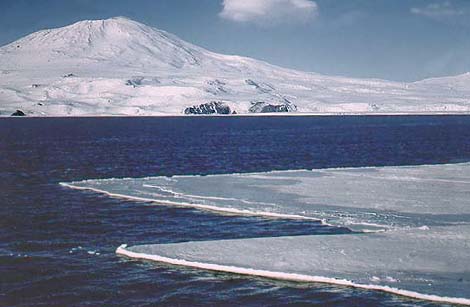
Mt Erebus, (13,000ft) McMurdo Sound, Antarctica.
No fume cloud today, but a lenticular cloud has been formed by a northerly wind.
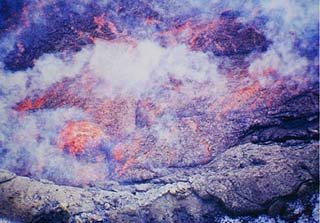 |
| Phonolite magma circulating in inner vent of Erebus, (Antarctic NZ photo). Phonolite seems to be extremely fluid, the Nyiragongo lava in 1977 flowing at 70 km/hr. after the breaching of the crater lava lake, Phonolite forms more volcanic necks than any other type, Ua Pu in the Marquesas is studded with them. |
Mt Erebus, is the only active phonolite (or "Kenyte", a kenyte being a lava studded with 1inch (=2.5cm) anorthoclase crystals and seen elsewhere only in Mt Kenya, Africa) volcano in the world, but in spite of the fact that Erebus sometimes throws out very large (3in) anorthoclase crystals embedded in glass, it is not a very highly fractionated member of the phonolite series, as, while depleted in Sr, P, and Ti, it has only just begun to diminish in Ba. The phonolites of Scott Island are similar. More highly evolved phonolites are seen on the eastern slopes of Mt Terror at Cape Crozier (Phil Kyle, data). The Boina pantellerites in the Afar Rift (Barberi, 1975, J.Pet.) also show very depleted Sr, P, Ti but not Ba. Some of the phonolites of the Dunedin Volcano in New Zealand show very strong Ba depletion compared with slight depletion for two trachytes. Rb and Zr reach levels of 270 and 400-1500 ppm, but unfortunately there are no Cs data. With Th at 70 ppm and U at 18, these rocks must have a high background radiation.
 |
Mt Erebus basanite - phonolite, Antarctica. |
 |
Phonolites and 2 trachytes of the Tertiary Dunedin Volcano, New Zealand the most evolved being from the Mt Mopanui plug. |
The conclusion is that is, on the whole, little difference between the minor LILE element abundance in phonolites and rhyolites. A pronounced negative Nb-Ta anomaly is present in continental rhyolites but not in those found on oceanic islands such as Iceland nor is one present in trachytes or phonolites.
The Zr content for the highly evolved Valles Rhyolite is however quite low, with a max of 140ppm, compared to 370 for the Puyehue rhyolites, 950 ppm for Erebus phonolites, 1550ppm for Dunedin Volcano, phonolites, (the Mopanui plug), and 2000 ppm for the high Zr Naivasha commendites.
Sodic and Potassic Granites
The question needs to be looked at; are the granite-syenite suite merely the coarse-grained equivalents of the rhyolite - trachyte rocks or are they perhaps different? Sampling is something of a problem, granites can be REALLY coarse grained. When a potash feldspar is 3" long and an albite an inch or more one feels like mashing up quite a large volume of rock before it can be said to be homogenous. Then granites are so often banded, or become lighter or darker or finer grained as one walks over an outcrop. Really potassic granites become simply masses of pegmatite, a nice red potash feldspar may be 6" across, quartz crystals projecting into cavities may be pyramidal hexagons 4" across, a book of muscovite a foot, great stuff if you wish to look at the trace elements in muscovite. Spodumene crystals can look like concrete posts buried in rock, tourmalines may be several inches long, their may be great lumps of beryl or molybdenite. So expect a lot of scatter in your bulk data when you get to the very potassic end-members.
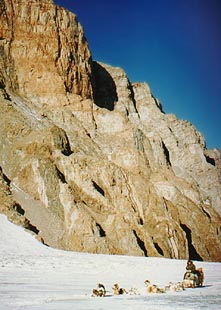 |
A glaciated wall of Lower Paleozoic potassic post-tectonic granite at Miller Glacier, near Granite Harbour, Antarctica. It is cut by lamprophyric vertical dikes. |
Granite complexes tend to be found in the eroded roots of old andesite arcs, chains of (mainly) granodiorite batholiths lie along the older sierras of Peru to seaward and between the active andesite zones. Similar batholiths lie along the Sierra Nevada. Granite complexes are best seen in the Archean terraines especially where glaciated, as in Antarctica and northern Quebec and Ontario. Generally the older rocks are sodic trondhjemites, rather sheared and gneissic, of what I once called the "Pretectonic suite". Younger crosscutting granitic intrusions are more potassic, though there may be odd small domes of diorite or larger ones of granodiorite, gabbro almost never. The youngest granites are usually the most potassic with large pink potash feldspars. 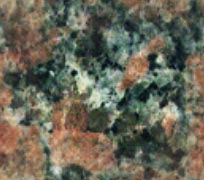
> Typical potassic granite. >
 |
The Nevada batholith, Tuolumne Series. Note similarity to moderately fractionated rhyolite. |
| New England Granite, Australia. This has a more dacitic fingerprint. |
 |
The Mt. Gharib granite, Egypt. |
| The Latir Granites, New Mexico. Note the progressive decrease in Ba, Sr, P, Ti especially. The Nb anomaly becomes less distinct as Nb builds up with fractionation. |
 |
Some old data on Archaean granite-granodiorite of Northern Quebec. (Apologies for the few elements, no ICPMS in those days.) It does show the pronounced difference between the somewhat gneissic early granodiorites or trondhjemites and the later potassic granites. |
| The Chibougamau and the Opemisca batholiths are distinct. |
Note that all have a classic orogenic continental signature. No REE I fear for the Quebec Archaean, but an indication is given of the range to be encountered. Granodiorites do not in fact have different trends to andesites, but pegmatites have an erratic, but probably on average, similar, composition to rhyolites.
Lamprophyres, Lamproites, Kimberlites & Other Oddities
Again, lamprophyres are odd rocks, usually occurring as a late stage intrusive into granite complexes, often as sheeted dikes as in South Victoria Land, but sometimes as old plugs and necks as in Agathla and Ship Rock, New Mexico. Phenocrysts may be biotite, hornblende or even clinopyroxene. They are quite alkaline in composition, but seem to always show a typical orogenic fingerprint with marked Nb-Ta depletion. Unfortunately some authors are rather sloppy in their petrography, they describe rock suites from western USA and Mexico as alkaline, and their fingerprint may progress from almost oceanic to quite orogenic. Some such rocks described are lamprophyres, others may be, but we are given not enough detail. Are all rocks of alkaline composition, but orogenic fingerprint lamprophyres? I don't think we can say at this point.
|
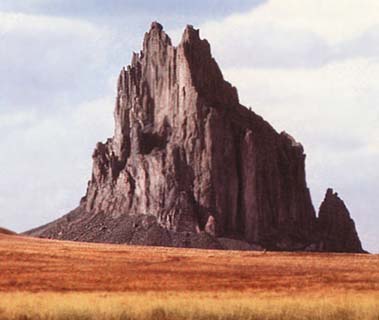
Ship Rock minette towering 1400ft above the New Mexican desert.
|
 |
Kimberlites (diamond pipes) from the Archaean terranes of Finland. |
No one would deny that carbonatites are odd rocks. They are usually associated with other alkaline intrusions in continental areas, especially with syenites. Personally I do not know of any carbonatite associated with alkaline association on oceanic islands except in the Canary Is. Apparently if CO2 pressures are high enough, calcium carbonate will form and flow as a magma bringing with it many rare minerals and odd element concentrations. Alternatively sodium carbonate may form. Minerals of Ce, Y etc. may occur as some REE reach very high levels.
The fingerprints are usually highly erratic, but the REE are more regular. The examples shown are for a natrocarbonatite from South Africa and a calcite carbonatite from Algeria. The La/Lu ratios are the highest known, at least to me, and the ratio of La/Ce exceeds 1. (In more "normal" rocks it is close to 0.5 being least in MORBS and greatest in alkaline rocks. In the natrocarbonatite, La is present at 300-450ppm levels.
 |
Natrocarbonatite - South Africa |
| Calcite carbonatite - Algeria |
Back
Copyright © Dr B.M.Gunn 1998-2003
|